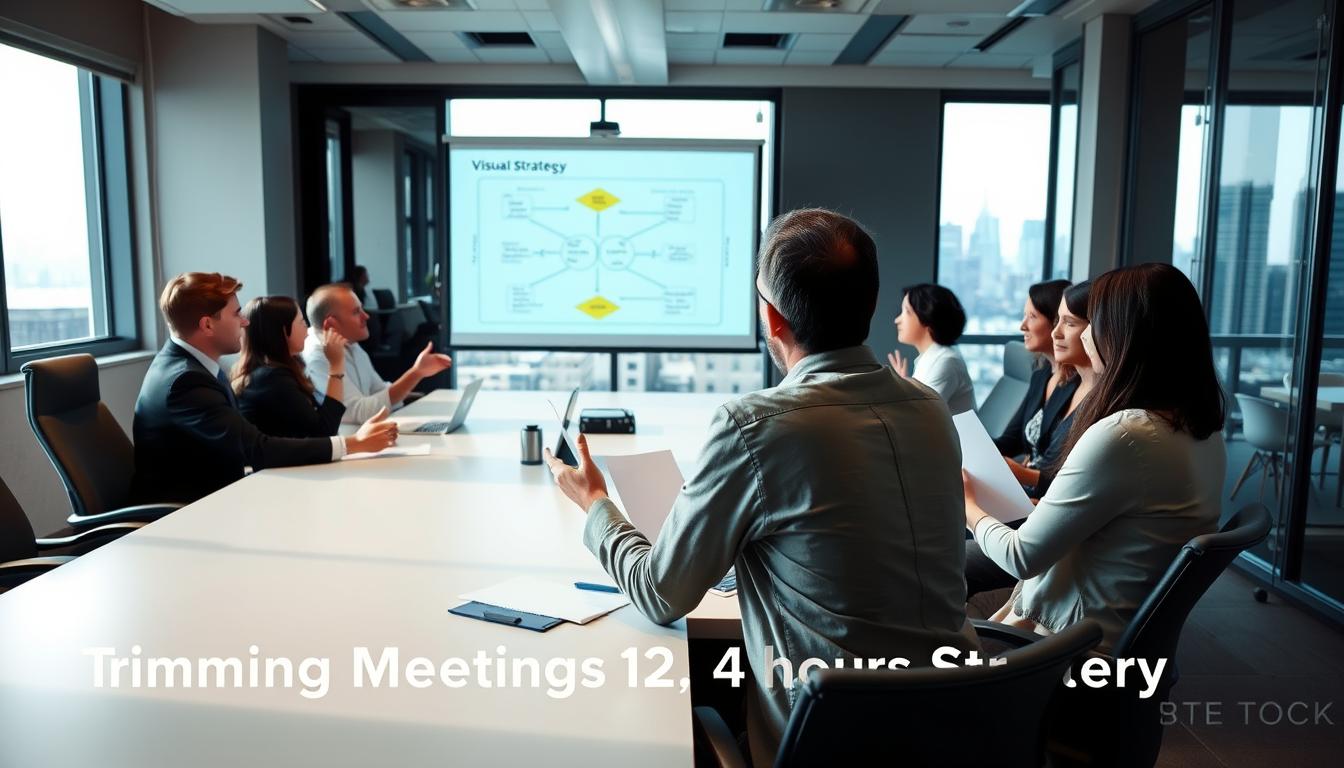In today’s quick-moving work world, keeping an eye on your internal meetings is crucial. Studies show unproductive meetings cost U.S. businesses about $37 billion every year. It’s important for companies to spot when meetings are more of a setback than a help to team productivity. We will look into the major signs that your meetings may be pulling your productivity down, not pushing it up.
Understanding the Impact of Internal Meetings on Productivity
Internal meetings are key in defining how a team works together and their effect on productivity. If organized well, they help with clear communication and teamwork. However, if the goals are not clear, these meetings can be confusing and waste time, making employees feel like their hard work isn’t going towards the right goals.
To get the most out of meetings, it’s important for companies to know how their teams prefer to work and communicate. Looking at how everyone communicates can show what needs to get better. This ensures that meetings really help with what the team needs instead of just being a check-box task. By tailoring meetings to fit how a team operates, companies can boost their productivity and create a place where everyone feels involved.
Wasted Time Equals Wasted Money
Unproductive meetings can really hurt a company’s wallet. Studies show big losses in money because of time spent in bad meetings. Employees spend around 31 hours every month in meetings that aren’t needed. This not only cuts into work time but also means a lot of money is lost. Smaller businesses can lose hundreds of thousands, and big companies even more.
The Financial Drain of Unproductive Meetings
Bad meetings are a clear drain on money. When time is wasted, it hurts how much work gets done and how well the company does overall. It’s key for companies to look closely at how they do meetings. In a world where being the best is important, saving time is key for being successful.
Statistics on Time Lost in Unproductive Meetings
Stats often show that many meetings don’t lead to anything good. A study says that leaders find only about 60% of meetings useful. This shows we need to make meetings better quickly. By knowing this, companies can look at their meeting ways. Fixing these issues helps save money.
Signs of Meeting Fatigue Within Your Team
It’s important to spot when your team is tired of meetings. If team members lose interest, their work suffers, and morale drops. Catching these signs early helps you fix issues before they get worse.
Identifying Symptoms of Engagement Drop-off
Look for these signs of meeting fatigue among employees:
- Lack of talking in meetings, leading to silence.
- Same old topics that don’t bring up new ideas.
- Doing other tasks in meetings, like checking emails.
- Not showing themselves in virtual meetings, showing disinterest.
These signs mean your team’s engagement is falling. This puts your team’s success at risk.
Effects of Meeting Fatigue on Employee Morale
Long-term meeting fatigue can hurt team spirit. When people are continuously disengaged, it creates a bad vibe. This can cause:
- More arguments, as people get frustrated.
- People leaving their jobs for more enjoyable ones.
- Burnout, making performance drop significantly.
Dealing with meeting fatigue is key to keeping a workplace happy. This makes sure everyone is excited to achieve the company’s goals.
The Costly Consequences of Poor Meeting Structure
Organizations without a clear meeting agenda face negative outcomes. Undefined objectives lead to meetings going off track. This can result in lost time and lower productivity. In such meetings, pointless discussions are more likely to happen.
Lack of Clear Agenda or Objectives
Meetings without a clear purpose cause confusion. Participants may not know why they’re there, leading to off-topic chats. This not only annoys team members but also weakens the meeting’s value. A well-planned agenda ensures meetings stay focused and productive.
Decision-Making Bottlenecks and Their Impact
Lack of role clarity can slow down decision-making. This often leads to revisiting the same points without any outcome. It frustrates teams and causes delays. Structured meetings with clear agendas help teams make decisions faster. This cuts down on time wasted on unresolved matters.
3 Signs Your Internal Meetings Are Killing Productivity
Noticing when meetings start to hurt your team’s morale and output is key. If meetings cause burnout or lower productivity, that’s a bad sign. Also, when projects are always late, it means something is wrong. And if everyone is sending too many emails, it’s chaos. These issues mean you might need to change how things are done.
Burnout and Low Productivity Correlation
Too many pointless meetings can make workers feel tired and less involved. This leads to them getting less done, missing deadlines, and not reaching their targets. If your team keeps feeling burned out, it could cause bigger problems for everyone.
Overdue Projects as a Red Flag
When projects are always late, it shows your meeting setup isn’t working. This might be because meeting directions aren’t clear. Delayed projects make everyone more stressed and unhappy at work. This just adds to the pressure.
Email Overload and Communication Breakdown
Getting too many emails usually means talking in meetings isn’t working. If important things aren’t getting resolved, everyone ends up emailing back and forth. This leads to confusion and makes it hard to get things done. It can also make the burnout problem even worse.
Decision-Making Styles: Concordant vs. Authoritative
Understanding how a team makes decisions can vastly improve teamwork. Teams become more efficient by recognizing whether they use concordant or authoritative ways of deciding. This knowledge cuts down on meeting irritations and lets everyone act with a shared understanding.
The Benefits of Identifying Your Team’s Style
Knowing if your team is more concordant or authoritative brings several positives. Teams that lean concordant are big on working together and sharing ideas, which boosts creativity. On the other hand, authoritative teams make quick decisions, which is key in time-sensitive moments. This insight helps tailor meetings to fit the team’s decisiveness, making them more effective.
How Decision-Making Styles Affect Meeting Dynamics
The way a team decides things can change how meetings go. Teams that prefer a concordant style tend to talk more and include everyone’s opinions. This makes meetings more engaging. Meanwhile, authoritative decision-making can make discussions quicker and avoid unnecessary delays. Knowing this helps shape meetings that fit a team’s unique way, boosting productivity and results.
Shorter, More Effective Meetings
In today’s world, long meetings can steal precious time. Short ones keep everyone lively and attentive. By focusing on quick, efficient get-togethers, we can lessen tiredness. This also sparks more creativity and team cooperation.
Strategies for Reducing Meeting Length
Want your meetings to be powerful but short? Try these tips:
- Set strict time limits for each meeting.
- Prioritize key discussion points to streamline conversations.
- Incorporate time management tools such as timers or agenda reminders.
- Encourage participants to prepare beforehand, allowing for quicker dialogue.
Creating Focused Agendas for Maximum Impact
A well-thought-out agenda is key for efficient meetings. It should lay out goals to keep things on track. Remember:
- Outline specific topics and allocate time to each.
- Limit agenda items to avoid overwhelming discussions.
- Include roles for participants to promote accountability and engagement.
No-Meeting Days: Enhancing Productivity
In our busy work life, no-meeting days are becoming a key way to improve productivity. By setting aside specific days without meetings, companies give their employees time to focus deeply on their work. This method helps people work better and come up with more creative ideas.

The Importance of Dedicated Focus Time
Having time to focus helps employees do their best work, leading to better results. On days without meetings, team members can solve tough problems, plan strategies, or catch up on work. This period of undisturbed work makes employees feel more accomplished and responsible.
Examples of Companies Implementing No-Meeting Days
Several forward-thinking companies have seen great results from having no-meeting days. For example, Asana has special days set for focused work, making the workplace more peaceful. Similarly, Meta gives its staff days off from meetings to recharge and dive deep into their projects without distractions.
- Asana encourages individual productivity on designated days.
- Meta fosters creativity and collaboration through uninterrupted focus time.
No-meeting days offer a way to deal with the tiredness from constant meetings while boosting productivity in our demanding work culture.
Over-Reliance on Meetings for Communication
Many organizations rely too much on meetings for talking with each other. This dependence can slow down work and make teamwork harder. Exploring other ways to communicate can make work go smoother and improve how teams perform.
Alternatives to Meetings for Effective Collaboration
There are plenty of other ways to work together without always meeting in person. Here are some options:
- Email updates for status reports and project progress.
- Real-time messaging platforms like Slack for quick questions and feedback.
- Project management tools such as Trello or Asana to track tasks and responsibilities.
- Collaborative documents in Google Workspace for simultaneous input and editing.
Trying out these methods can keep everyone updated while cutting down on meeting times.
Analyzing Team Communication Habits
Looking closely at how teams talk to each other can show when meetings are needed or not. Asking for team feedback or doing surveys can uncover habits. Maybe updates that take a long time in meetings could be shared faster in a message.
By understanding these communication patterns, we can talk more effectively. This saves time for everyone involved.
Improving Meeting Effectiveness
To make meetings better, we need a good plan. Focus on being clear and engaging to turn slow meetings into productive ones. Use the best tools for meetings to help everyone work better together.
Best Practices for Running Engaging Meetings
Keeping everyone involved is key to great meetings. Here are some tips:
- Have a clear plan ready before the meeting starts.
- Only invite people who need to be there.
- Make sure everyone gets a chance to speak.
- Choose someone to guide the discussion.
- Aim to reach specific goals by the end of the meeting.
Tools for Enhancing Meeting Productivity
Using the right tools can make meetings much better. These tools make it easier to work together, no matter where everyone is:
- Video conferencing platforms like Zoom or Microsoft Teams.
- Project management tools such as Asana or Trello.
- Real-time collaboration tools like Google Docs or Miro.
- Scheduling aids like Doodle or Calendly for efficient time management.
Creating a Healthy Meeting Culture
Building a good meeting culture is key to making team members feel safe to share ideas. Open communication is really important in this. It lets everyone speak up. This helps meetings and productivity get better. Trust in the team is also crucial. It makes working together easier and creates a feeling of belonging.
Encouraging Open Communication and Feedback
Open communication can change meeting dynamics. When teams focus on feedback, they make a place where all voices matter. Suggestions are taken seriously. Because of this:
- Goals become clearer.
- Everyone gets involved more.
- It leads to a team that solves problems together.
Building Trust Within Your Team
Trust is the foundation of great meetings. When team members trust in each other’s skills and good intentions, they speak more freely. This leads to:
- Fewer misunderstandings and less conflict.
- More creative ideas, as people aren’t afraid to share.
- Better teamwork on many projects.
Conclusion
Throughout this article, we learned how to spot the signs of harmful internal meetings. Wasted time and resources, along with lower employee engagement, are big red flags. Each sign points to deeper problems that need fixing.
Companies should often check how they handle meetings. They should use firm agendas, welcome honest feedback, and try new ways of communicating. These steps can make meeting culture much better. This change will lead to more productive meetings.
In short, making meetings more efficient is key for success. By paying attention to what we discussed, teams can become more united. And this unity leads to better results and keeps the team working well together.



